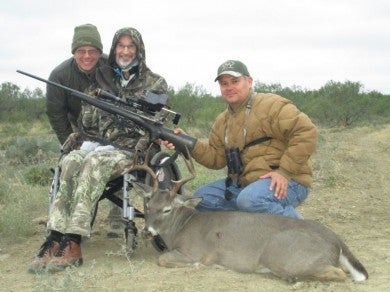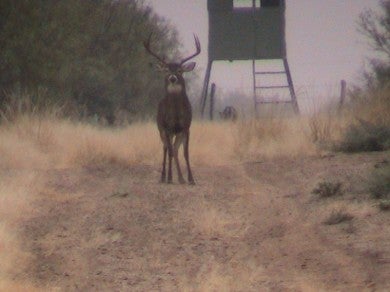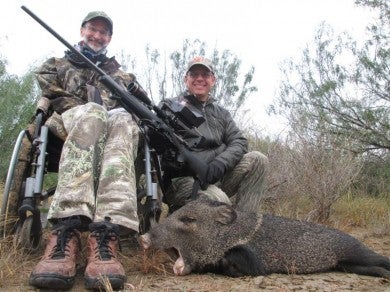Mexican Whitetails: Good Hunting Awaits Just Across the Border
Andy Hahn 03.20.14

Opening day of deer season. Low, gray clouds scudded across the sky as a harsh November wind shook our ground blind. The previous day had been balmy and comfortable, but then a nasty cold front roared in. “The deer are all bedded down,” I thought disappointedly. “There’s no way they’ll be out in this weath–”
“One coming in on the right!” murmured my guide, Ruben Serna. Raising his binoculars for a better look, Ruben said, “Eight points, but it’s a cull buck.”
My friend Ron Wagner’s eyes grew wide when the deer cautiously stepped into the open. “It would be a cull buck back home, too,” he quipped. “If you shoot a buck like that in Pennsylvania, you pick up the phone and ‘cull’ all your friends to come over and see it!”
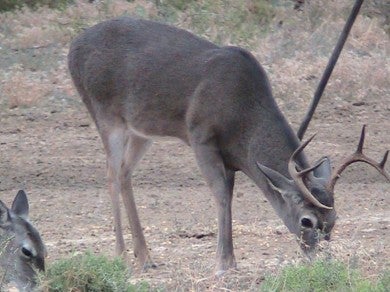
But we weren’t in Pennsylvania.
Six months earlier I had been casually clicking through videos on YouTube when a short one about hunting whitetails in Mexico caught my attention. Although I knew Sonora is a mecca for mule deer hunters, I had never realized you could target whitetails in Mexico. This possibility interested me for a combination of reasons: I grew up an avid outdoorsman in Pennsylvania but I now reside in Brazil, a country with no legal hunting opportunities; I have ALS, a neurological disease that has put me in a wheelchair and rendered my arms useless; adaptive shooting gear enables me to keep hunting, but I can’t travel alone; entering Mexico requires no visa, while getting a USA visa for my Brazilian aide is a complicated, expensive procedure; oh, and I’m always up for new adventures.
When I saw a chance to hunt whitetails in a place that presented no visa hassles for my aide, I began researching the topic on the Internet. The Mexican states of Coahuila, Nuevo Leon, and Tamaulipas lie just across the Rio Grande from Texas, and the quality of their deer hunting rivals that found in the Lone Star State. In fact, it’s not uncommon for Texans to secure hunting leases south of the border.
Up to the Challenge
After studying several outfitters’ websites, I contacted Rancho el Nido because they offer whitetail packages at reasonable prices. When I asked if they were willing to have a person in my condition at the lodge, the owner, Ruben Serna, said, “We’ve never hosted a wheelchair hunter before, but I’m sure we can make it work. Access won’t be a problem because there are no stairs in the guest house, and you can hunt in ground blinds.”
Ruben’s can-do attitude gave me the confidence to book a four-day hunt to begin on November 22, 2013—opening day of deer season in Tamaulipas. My next task was to convince my longtime hunting buddy to join me for the adventure.
“Whitetails? In Mexico?” Ron asked. “Count me in!”
We coordinated travel plans to arrive the evening before our hunt began. Ruben picked up Ron and his wife, Pagey, in Laredo, Texas. The three of them then greeted Ricardo (my aide) and me at the airport in Nuevo Laredo, Mexico. Less than an hour later we were unloading our gear at the ranch, where Rolando the cook was busy grilling steaks over mesquite embers. Dinnertime conversation focused on our strategy for the next day. The long trip from Brazil had tired me out, so we decided it would be best to sleep in, set up my adaptive shooting equipment, and hunt in the afternoon.
After a late breakfast, Ron and Ricardo rigged my gear on a 7mm Mag that Ruben provided as a loaner. My scopecam mounts on nearly any optic and displays the scope’s-eye view, crosshairs and all, on a 2.5-inch color monitor. The screen allows both of us to view the sight picture as Ron aims the rifle for me. When the aim point looks right, I fire the rifle by inhaling on a tube to activate a special trigger control.
As Rolando prepared lunch, a screaming north wind announced the arrival of a cold front. Within two hours the temperature had dropped more than 20 degrees; the mercury hovered at the 33-degree mark and the wind continued to howl. Despite the discouraging weather, we headed out at 3:30.
Rancho el Nido is a low-fence, working cattle and sheep ranch that covers 5,000 acres of mesquite scrub. Like the brushy terrain, hunting techniques here mirror those found across the border in south Texas. Hunters sit in pop-up blinds or elevated box blinds overlooking openings where corn feeders draw deer out of the thick cover. Another option involves slowly patrolling the ranch’s far reaches in a pickup, pausing often to glance for deer in the brush or on the long, straight two-rut roads.
Ten-Point Surprise
“Today we’ll try a spot that I’ve set up just for you,” Ruben told me. “It has a large ground blind that should hold all of us comfortably.”
After watching the brush dance in the fierce wind for an hour, I was convinced that no whitetails would be moving until the front blew through and the weather stabilized. That’s when the eight-point appeared, walking toward the feeder 70 yards away. Three does soon joined it, and the little party kept us entertained for about 30 minutes. The party ended when all four deer suddenly snapped to attention, looked toward our right, and hurried off in the opposite direction.
“There’s a big buck at the edge of the scrub,” Ruben whispered, binoculars glued to his eyes. “Ten points.”
Moments later, the buck confidently stepped forward. As Ron and I ogled the biggest whitetail we’d ever seen, our guide calmly said, “There are bigger bucks on the ranch, but he’s a good one. You wanna take him or would you rather wait and try to find another one? We still have three more days.”
I like to push the limits regarding what a man with ALS can do, but I’ve learned not to push my luck. While I appreciated the fact that Ruben wasn’t trying to pressure me into shooting a particular deer, I couldn’t gamble away this golden opportunity at a gorgeous ten-point standing just 75 yards away.
“Let’s take him,” I said.
I figured I’d made the right choice because Ron never questioned my decision. Instead, he carefully put the rifle on shooting sticks. As soon as our quarry turned broadside, Ron flicked off the safety and held the crosshairs on its left shoulder. When I touched off the shot, the buck ran just 40 yards before collapsing. There was no ground shrinkage when Ricardo finally wheeled me close to the deer for photos. The rack later taped out at 140, with a 19-inch spread.
With our prize loaded in the pickup, we were all smiles during the 15-minute drive back to camp. As we neared the ranch house I asked Ruben to beep the horn loud and long. Pagey and Rolando came out and congratulated us on taking such a fine buck.
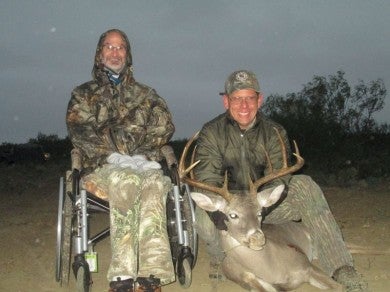
Stalking Javelina
The weather remained cold and breezy with an intermittent, drizzling rain the next morning. The crew enjoyed a leisurely breakfast before setting out at 11 o’clock to look for javelina (collared peccary). This time our guide was Arturo Garcia. Ricardo, armed with a .243, was ready for his first-ever hunt. Our plan was to drive slowly along the ranch roads and let Ricardo put the sneak on any peccaries we located.
Easier said than done! To my surprise, we saw dozens of deer out and about in the middle part of the day. But where were the porkers? “We usually see javelina all over the place,” Arturo said. “This cold front must have them hunkered down in the thick stuff.”
We finally spotted a javelina 150 yards away. Arturo and Ricardo got out of the truck quietly and managed to cut the distance in half with a careful approach. Placing the rifle on shooting sticks, Ricardo took aim and fired. A small geyser of dirt erupted under the pig’s chin, sending the startled critter scampering for cover.
A thorough search revealed no sign of blood, so Arturo and Ricardo returned to the pickup. I offered Ricardo encouragement: “A clean miss is better than a bad hit. At least we know the javelina isn’t wounded and suffering.” Ricardo showed the right attitude by answering, “I’ll get the next one.”
Twenty minutes later he had his chance. The ranch’s maintenance roads form a grid pattern, and we had slowly gone “around the block.” Just before we reached the spot where we’d seen the javelina, Arturo stopped the truck and suggested that Ricardo get out and peek around the corner. The same javelina—a 50-pound boar—had come back out. This time the novice hunter aimed true and dropped his quarry with an 80-yard shot.
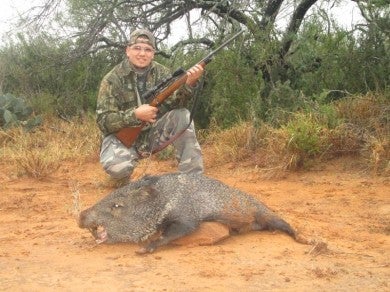
Upholding our recently established tradition, we asked Arturo to lean on the horn when we returned to the ranch house.
That horn did a lot of singing over the next few days as we also took the eight-point management buck and three more javelinas. Check out our video highlight reel:
Why Hunt in Mexico?
A trip to Mexico not only offers the chance to extend your hunting season without having to endure frigid temperatures, it adds an international flair to the adventure. “I had a great time and would recommend it to other American hunters,” says Ron Wagner of his first south-of-the-border whitetail hunt. “My wife and I enjoyed meeting the people, experiencing a foreign culture first-hand, and trying new foods. It was also interesting to see an entirely different ecosystem and how deer have adapted to it.”
Okay, but what about the hunting?
“The quality and quantity of bucks is like nothing I’ve ever seen in my home state of Pennsylvania,” Ron affirms.
Best of all, the cost can be considerably less than that of a comparable hunt in the USA. In the 2013-14 season I paid $2,850 for a trophy buck package, which included a deer of my choice (Rancho el Nido trophies typically score more than 130 B&C) and a javelina. A management buck package cost $1,850. For more information, see the Rancho el Nido website at www.ranchoelnido.com.
Documents and Other Details
While it’s possible for American citizens to drive their own vehicles into Mexico, full-service outfitters provide transportation across the border, meeting clients in the US (in towns like Laredo, Texas), and accompanying them through customs. To enter Mexico and, more importantly, reenter the US, you MUST have a passport.
Hunters may bring two rifles (absolutely no handguns), with up to 40 rounds of ammo for each, if they’ve filled out the proper forms and paid the $200 fee. In an effort to spare their clients this headache, many outfitters offer loaner rifles. Carrying a bow into Mexico requires no papework or fee. Deer tags cost $125.
Customs agents will not let you cross the border with fresh venison. Not to worry: The locals enjoy eating game. To prevent the spread of cattle ticks, untreated deer hides may not enter the US. If you want to bring home a cape for mounting, ask your outfitter how to proceed.
At no time during my visit to Mexico—a total of seven days in and near the city of Nuevo Laredo—did I feel unsafe or threatened in any way.
